|
1996, 1997,
1998 Britannia Internet Magazine, LLC

Pre-reading
Discussion
1) Describe
in your own words/ideas what Stonehenge is.
2) What is the significance of Stonehenge? Is there a significance?
Explain.
1 The
megalithic ruin known as Stonehenge stands
on the open downland of Salisbury
Plain 2 miles (3 kilometres) west of the town of Amesbury, Wiltshire,
in Southern England. It is not a single structure but consists
of a series of earth, timber, and
stone structures which were revised and re-modeled
over a period of more than 2000 years.
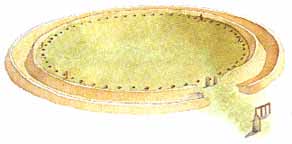 |
Stonehenge
I (3100-2300 B.C.E.) (image from Mohen,
p. 30) |
2 The earliest
portion of the complex,
which dates to approximately 3100-2300 B.C.E.,
comprised a circular bank-and-ditch
of about 330 feet (100 metres) in diameter.1Just
inside the earth bank was a circle of the 56 "Aubrey
holes" (now invisible on the surface).
Probably dating to this time also the four "Station Stones" (only two
of which survive), and on the north-east
side, an earthwork Avenue
which runs from the break in the bank-and-ditch were added.2The
now-fallen "Slaughter Stone", located at the break in the bank-and-ditch
may date from this period, as may also the "Heel Stone", located further
out along the Avenue.3
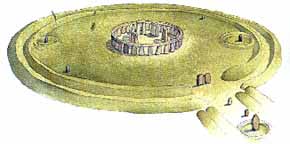
Stonehenge IIIa (2100-2000
B.C.E.) (image from Mohen,
p. 30)
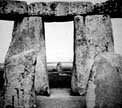
View from the center of Stonehenge towards
the "HeelStone". |
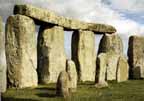
Part of the outer
of sarsens
(added around
2100-2000 B.C.E.).
In front of them
are stones of the bluestone circle
(added around
1550-1100 B.C.E.) |
3
Around 2100-2000 B.C.E., a circle about 108 feet (33 metres) in diameter
comprised originally of 30 neatly trimmed
upright sandstone blocks (known today as "sarsens"),
standing on average 13 feet (4 metres) above the ground, about 6.5 feet
(2 metres) wide, and 3 feet (1 metre) thick, supporting a continuous
ring of sarsen lintels (held in
place by tongue-and-groove
joints) was constructed in the centre of
the original circular bank-and-ditch.4
A little later were added inside the circle of sarsens, in the shape
of a horseshoe, ten upright
sarsens arranged as five pairs with a single lintel.5
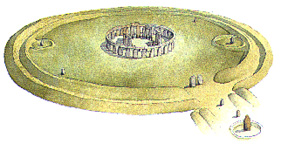 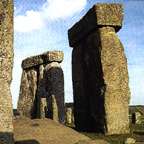
(above left) Stonehenge IIIb (2000-1550 B.C.E.) (image
from Mohen,
p. 31)
(above right) Two of the trilithons (added around 2100-2000
B.C.E.).
In front of them are two upright stones of the bluestone
horseshoe (added around the same period)
4 Around
2000-1550 B.C.E., a horseshoe of smaller upright igneous
stones without lintels, the "bluestones",
was evidently brought from a geological site in Wales.
5 Finally,
around 1550-1100 B.C.E., a circle of smaller upright bluestones was
added between the outer sarsen circle and the outer horseshoe. Also
added around this time are two concentric circle
of holes -- the so-called 'Y' and 'Z' holes.
|
